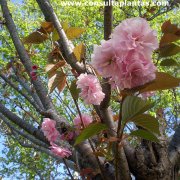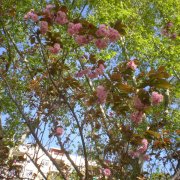Care of the tree Prunus serrulata or Japanese cherry |
|
The genus Prunus, family Rosaceae, comprises 200 species of trees and shrubs native to temperate regions of the Northern Hemisphere. Some species are: Prunus serrulata, Prunus dulcis, Prunus cerasifera, Prunus avium, Prunus laurocerasus, Prunus domestica, Prunus mahaleb, Prunus lusitanica, Prunus spinosa, Prunus persica, Prunus armeniaca, Prunus cerasus, Prunus incisa. Common names: Japanese cherry, East Asian Cherry or Japanese Flowering Cherry. This species is native to Japan, Korea and China. They are deciduous trees with a shiny brown trunk and erect branches that reach 5 meters (16.4 feet) in height. The oval leaves are glossy dark green with a serrated margin. The very showy flowers appear before the leaves or at the same time as the leaves and can be white or pink. They bloom in spring. The fruits are small and black. Japanese cherry is used in rows, in small groups, as isolated specimens and in public parks. Prunus serrulata grows in full sun (cool-temperate climates) and semi-shade (Mediterranean climates) exposures. It resists frost well. The soil can be a normal, well-drained garden soil with coarse sand and a little organic matter; East Asian Cherry resists calcareous soils. Water regularly so the substrate never dries out completely. Japanese cherry does not resist drought or waterlogging. Fertilize with compost or manure in autumn and with mineral fertilizer in early spring. East Asian Cherry should never be pruned. Prunus serrulata is a quite resistant plant to the usual pests and diseases. Japanese cherry is propagated by woody cuttings and by grafting onto wild cherry trees in spring or summer. |
Images of the tree Prunus serrulata or Japanese cherry |
Find plants
Prunus serrulata or Japanese cherry | Cuidados
© 2026 FavThemes


